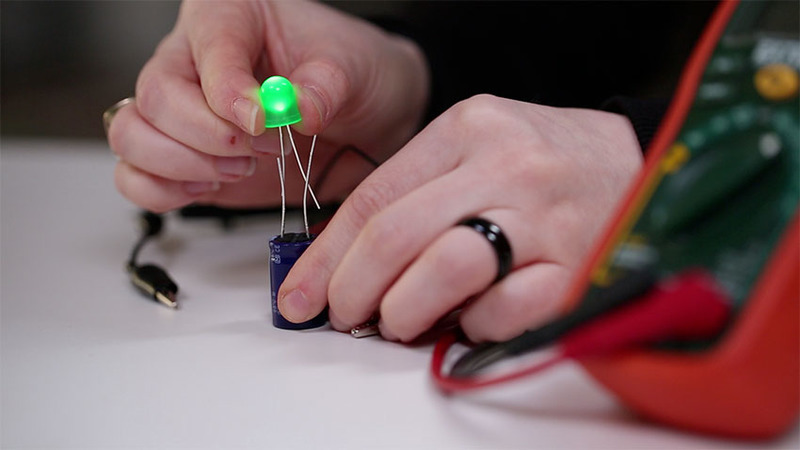A capacitor stores electrons using an electric field. The capacitor has two separated plates, where electrons are held. A voltage placed across the capacitor makes the electrons want to move from one plate to the other, but a 'dielectric' between the plates is there to make sure that they don't. The electrons can be stored on the plates until they are needed to make a circuit.
A capacitor stores electrons using an electric field. The capacitor has two separated plates, where electrons are held. A voltage placed across the capacitor makes the electrons want to move from one plate to the other, but a 'dielectric' between the plates is there to make sure that they don't. The electrons can be stored on the plates until they are needed to make a circuit.
Transcript
Ladyada: Needle-nose pliers …
Adabot: Needle-nose pliers.
Ladyada: Jumper wire …
Adabot: Jumper wire.
Ladyada: Capacitor …
Adabot: Umm … which one is the capacitor again?
Ladyada: Oh - it’s that one on the left …
Adabot: Ah-ha - Got it.
Adabot: Here is your capacitor.
Ladyada: Thanks.
Adabot: Ladyada, what does a capacitor do?
Ladyada: Oh - a capacitor stores electrical energy.
Adabot: But …isn’t that what a battery does?
Ladyada: Well yes - batteries & capacitors both store electrical energy. But aside from that, they’re quite different from one another.
Adabot: Ohhh … but what makes them different?
Ladyada: Batteries *create* their own electricity, and capacitors need to be filled up with electrical energy from an outside source.
Adabot: So a battery makes electricity … and a capacitor stores electricity?
Ladyada: Yup - you got it.
Adabot: Can a capacitor be filled up with electricity from a battery?
Ladyada: Definitely.
Adabot: Cool! … umm … but why would we want to do that?
Ladyada: Hmm - well there’s lots of reasons.
Maybe you should try asking a capacitor - ?
Adabot: Good idea - I’ll go ask Cappy!
Adabot: Hi Cappy - How are you today?
Cappy: Oh-ho hello there, Adabot! I’m doing quite fine, yourself?
Adabot: All my systems are fully operational, but I have a question - what exactly do you do here in this circuit?
Cappy: Oh - good question! Well, in this circuit, I am filtering power.
Adabot: Filtering … power … and how do you do that?
Cappy: Heh, well you see, this circuit is a power supply. We take electrical power in on one side, fix it up & smooth it out, then we send it out the other side.
Cappy: And I’m the part who does the smoothing. When too much electricity is coming in, I store the extra. And when too little electricity is coming in, I empty out my stored electricity to fill in the gaps.
Adabot: Wow - sounds like you’re a pretty *powerful* part around here!
Cappy: Heh - aye, you might say that, kiddo, yes. But capacitors do more than just filter power.
Adabot: Really? What else do they do?
Cappy: Hmm … let’s see …
Cappy: Capacitors store lots of power to help keep photos brightly lit.
Adabot: A camera flash?
Cappy: Precisely!
Cappy: When the power goes out, capacitors can help a computer run for a bit.
Adabot: Backup power?
Cappy: Right again!
Cappy: A capacitor can let low notes play while filtering out the higher ranges.
Adabot: … oh is that … an … audio filter?
Cappy: Correct!!
Cappy: Capacitors can block electron flow while passing along electrical changes.
Adabot: uhhh … I don’t think I know that one …
Cappy: Oh uhh - that *is* kind of a tough one, it’s called “AC coupling” … but umm … don’t worry about it right now!
Adabot: OK!
Cappy: There’s just one more thing you should know - some capacitors can dance!
Adabot: What?!?
Cappy: ah-do-do-do - da - da-do-dee-da
Cappy: Heh - well, I might be the only capacitor who dances … Still - capacitors do a lot of important work inside of circuits by storing & releasing electrical energy.
Adabot: Agreed - but where do you store all that energy? Do you have a backpack or some kind of big pocket?
Cappy: Hah no - I store electrical energy right here in my body!
Adabot: Woah!
Cappy: Inside every capacitor there are two electrically conductive plates separated by a layer of material that doesn’t conduct electricity.
Cappy: Electrical energy is stored in a capacitor when many electrons gather on one plate, attracted to the other plate which has more empty spaces for the electrons to fill.
Adabot: Oh - just like in a battery! The electrons crowd up on one side hoping they can fill in those empty spaces!
Cappy: Indeed. And a capacitor releases electrical energy when those electrons find an easier way to get to those open spaces by going outside of the capacitors body.
Adabot: Thanks, Cappy - capacitors make a lot more sense to me now!
Cappy: You’re very welcome, Adabot - glad I could help! Oh that reminds me - I should get back to work at the power supply circuit!
Ladyada: Hey - you’re back! So did Cappy tell you all about capacitors?
Adabot: He sure did - he’s a pretty amazing guy, and capacitors can be used in all sorts of different ways!
Ladyada: That’s true - and they also come in a lot different sizes & colors. Like these …
Adabot: Wow - those are all capacitors?
Ladyada: Yup - lots of different capacitors for lots of different jobs.
Ladyada: From teeny disks to ceramics, film, and electrolytic capacitors. We even have huge super caps.
Ladyada: Let’s try an experiment with this capacitor. This fellow has 10,000 microfarads of capacitance, and can be used up to 6.3 volts. I’m going to measure the voltage on this empty capacitor with my multimeter. Right now we’re at zero volts.
Adabot: Ladyada, there’s one thing I’d still like to know …
Ladyada: What’s that?
Adabot: Why don’t any of your capacitors dance?
Ladyada: What?
Adabot: You know - “ah-do-do-do - da - da-do-dee-da”
What is a capacitor?
A capacitor (originally known as a condenser) is a passive two-terminal electrical component used to store energy electrostatically in an electric field. The forms of practical capacitors vary widely, but all contain at least two electrical conductors (plates) separated by a dielectric (i.e., insulator). The conductors can be thin films of metal, aluminum foil or disks, etc. The 'nonconducting' dielectric acts to increase the capacitor's charge capacity. A dielectric can be glass, ceramic, plastic film, air, paper, mica, etc. Capacitors are widely used as parts of electrical circuits in many common electrical devices. Unlike a resistor, a capacitor does not dissipate energy. Instead, a capacitor stores energy in the form of an electrostatic field between its plates.
When there is a potential difference across the conductors (e.g., when a capacitor is attached across a battery), an electric field develops across the dielectric, causing positive charge (+Q) to collect on one plate and negative charge (-Q) to collect on the other plate. If a battery has been attached to a capacitor for a sufficient amount of time, no current can flow through the capacitor. However, if an accelerating or alternating voltage is applied across the leads of the capacitor, a displacement current can flow.
An ideal capacitor is characterized by a single constant value for its capacitance. Capacitance is expressed as the ratio of the electric charge (Q) on each conductor to the potential difference (V) between them. The SI unit of capacitance is the farad (F), which is equal to one coulomb per volt (1 C/V). Typical capacitance values range from about 1 pF (10−12 F) to about 1 mF (10−3 F).
The capacitance is greater when there is a narrower separation between conductors and when the conductors have a larger surface area. In practice, the dielectric between the plates passes a small amount of leakage current and also has an electric field strength limit, known as the breakdown voltage. The conductors and leads introduce an undesired inductance and resistance.
Capacitors are widely used in electronic circuits for blocking direct current while allowing alternating current to pass. In analog filter networks, they smooth the output of power supplies. In resonant circuits they tune radios to particular frequencies. In electric power transmission systems they stabilize voltage and power flow.
In October 1745, Ewald Georg von Kleist of Pomerania in Germany found that charge could be stored by connecting a high-voltageelectrostatic generator by a wire to a volume of water in a hand-held glass jar.[2] Von Kleist's hand and the water acted as conductors, and the jar as a dielectric (although details of the mechanism were incorrectly identified at the time). Von Kleist found that touching the wire resulted in a powerful spark, much more painful than that obtained from an electrostatic machine. The following year, the Dutch physicist Pieter van Musschenbroek invented a similar capacitor, which was named the Leyden jar, after the University of Leiden where he worked.[3] He also was impressed by the power of the shock he received, writing, "I would not take a second shock for the kingdom of France."[4]
Daniel Gralath was the first to combine several jars in parallel into a "battery" to increase the charge storage capacity. Benjamin Franklininvestigated the Leyden jar and came to the conclusion that the charge was stored on the glass, not in the water as others had assumed. He also adopted the term "battery",[5][6] (denoting the increasing of power with a row of similar units as in a battery of cannon), subsequently applied toclusters of electrochemical cells.[7] Leyden jars were later made by coating the inside and outside of jars with metal foil, leaving a space at the mouth to prevent arcing between the foils.[citation needed]The earliest unit of capacitance was the jar, equivalent to about 1 nanofarad.[8]
Leyden jars or more powerful devices employing flat glass plates alternating with foil conductors were used exclusively up until about 1900, when the invention of wireless (radio) created a demand for standard capacitors, and the steady move to higher frequencies required capacitors with lowerinductance. A more compact construction began to be used of a flexible dielectric sheet such as oiled paper sandwiched between sheets of metal foil, rolled or folded into a small package.
Early capacitors were also known as condensers, a term that is still occasionally used today. The term was first used for this purpose by Alessandro Volta in 1782, with reference to the device's ability to store a higher density of electric charge than a normal isolated conductor.[9]
Credits
- Ladyada – Limor Fried
- Adabot – Collin Cunningham & Phil Torrone, Puppet by Anney Fresh, design by Bruce Yan
- Cappy - Tom White
- Music: Tom White & Collin Cunningham
- Intro animation – Bruce Yan
- Written, filmed, edited, directed and produced by – Collin Cunningham, Limor Fried, Phil Torrone and the Adafruit team
This guide was first published on May 09, 2014. It was last updated on May 09, 2014.








































